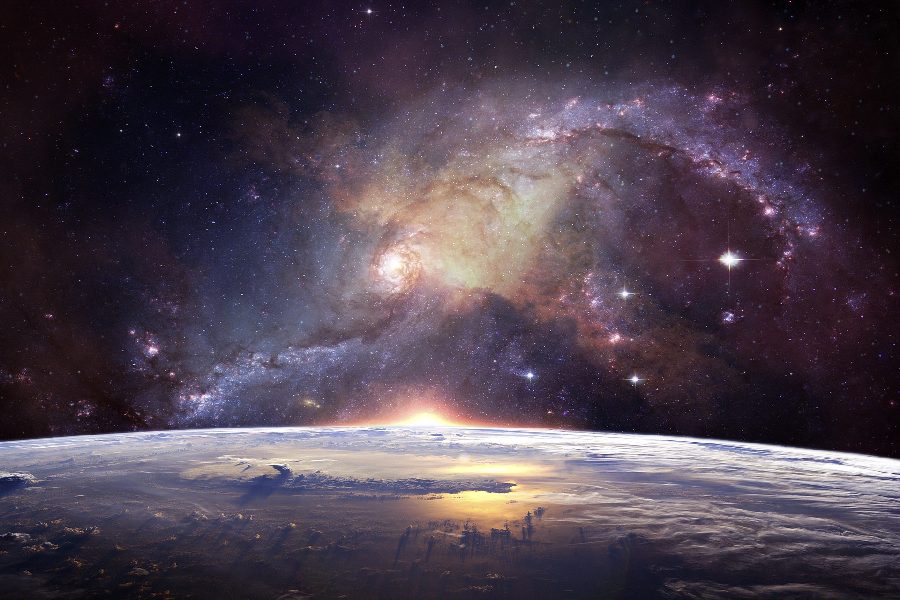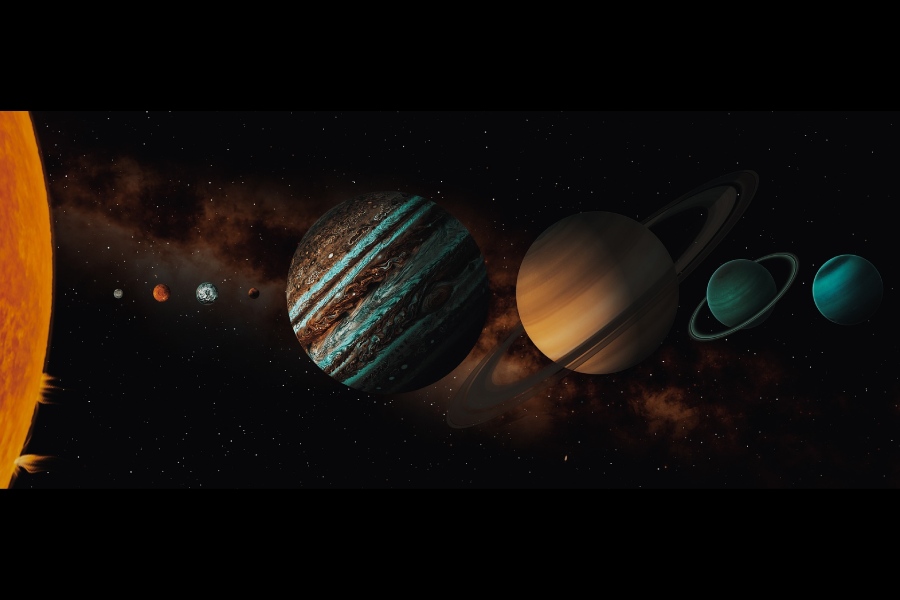The universe, which is a vast expanse of stars, galaxies, planets, and everything in between, has intrigued humanity since the dawn of time. We’ve often gazed up at the night sky and wondered what the universe is and how it works.
Ancient civilizations like the Egyptians, Babylonians, and Greeks had their own cosmologies. Some believed the Earth was the center of it all (geocentric), while others like Copernicus, Kepler, Galileo, and Newton sparked a scientific revolution by proposing a sun-centered (heliocentric) model.
This fascination with the universe has driven us to explore, to ask questions, and to seek answers. It’s what led ancient civilizations to build observatories, and it’s what sent modern spacecraft hurtling through the cosmos. We are compelled to understand our place in the universe and unravel its secrets.
In this article, we embark on a journey to explore the universe together. We’ll start by delving into the historical perspectives on the universe, and then we’ll fast forward to the present day to unravel our modern understanding of the universe, including the Big Bang theory.
What Is the Universe?
So, what is the universe? The universe, as we know it, is everything that exists – the vast expanse of space and all the matter and energy within it. It encompasses everything from the tiniest subatomic particles to the largest galaxies.
Imagine the universe as a grand cosmic tapestry, where each thread represents a star, planet, or some other celestial object, weaving together an intricate and awe-inspiring picture of existence itself.
Early Human Views on the Universe
Ancient cosmologies (Egyptian, Babylonian, Greek)
Long before telescopes and space probes, our ancestors marveled at the night sky and contemplated the nature of the universe. Different ancient civilizations had their own interpretations of the cosmos.
- Egyptian cosmology – The ancient Egyptians saw the universe as a harmonious and ordered system. They associated their gods with celestial bodies and believed that the cosmos mirrored the structure of their society.
- Babylonian cosmology – Babylonian astronomers were meticulous record-keepers of celestial events. They developed a system of predicting planetary movements and eclipses, laying the foundation for later astronomical observations.
- Greek cosmology – The Greeks, with thinkers like Aristotle and Ptolemy, contributed significantly to early cosmology. They both proposed a geocentric model where the Earth was at the center of the universe, surrounded by concentric spheres. This model dominated for centuries and influenced later ideas about the cosmos.
Geocentric vs. Heliocentric models (Ptolemaic vs. Copernican)
For many centuries, the geocentric model held sway. This model, often associated with Claudius Ptolemy, placed Earth at the center of the universe, with the planets and stars orbiting around it in complex epicycles. It was an intricate system that tried to account for the observed movements of celestial bodies.
However, a seismic shift occurred in our understanding of the universe with the work of Nicolaus Copernicus. Copernicus proposed a heliocentric model, suggesting that the Sun, not the Earth, was at the center of our solar system.
This heliocentric theory, outlined in his work De revolutionibus orbium coelestium (On the Revolutions of the Heavenly Spheres), challenged the long-held geocentric view and helped us progress in our quest to understand what is the universe.

The Contributions of Key Figures in Astronomy and Cosmology
Copernicus, Kepler, Galileo, and Newton
- Nicolaus Copernicus – Copernicus’ heliocentric model revolutionized our understanding of the universe. His groundbreaking idea laid the groundwork for modern astronomy. He proposed that Earth and other planets orbited the Sun in circular paths, challenging the geocentric view.
- Johannes Kepler – Kepler, building upon Copernicus’ work, formulated laws of planetary motion. His three laws described the elliptical orbits of planets around the Sun, and his work provided crucial evidence for the heliocentric model.
- Galileo Galilei – Galileo’s telescopic observations further confirmed the heliocentric model. He observed the phases of Venus, the moons of Jupiter, and the mountains on the Moon, all of which contradicted the geocentric view. His discoveries had a profound impact on our understanding of the cosmos.
Isaac Newton – Newton’s laws of motion and universal gravitation unified the celestial and terrestrial realms. His work explained the motion of planets, the tides, and the behavior of objects on Earth and in space. Newton’s laws provided a solid foundation for modern physics and astronomy.
The shift from a geocentric to a heliocentric universe
The transition from a geocentric to a heliocentric universe marked a pivotal moment in the history of science. It was a shift from Earth being considered the center of everything to recognizing that we are just one part of a vast solar system.
This transformation not only reshaped our view of the universe but also laid the groundwork for the scientific method and the pursuit of empirical evidence to understand the cosmos.
The works of Copernicus, Kepler, Galileo, and Newton collectively ushered in the era of modern astronomy and cosmology, setting the stage for further exploration towards unveiling what is the universe.

Modern Understanding of the Universe
The concept of the observable universe
Definition and limitations
The observable universe refers to the portion of the cosmos that we can detect and study using telescopes and other instruments. It is like a cosmic bubble around us, with Earth at its center. However, there are limitations to what we can observe.
The universe is vast and has been expanding for billions of years, which means that some regions of space are so far away that their light hasn’t had enough time to reach us since the Big Bang. This sets a limit on how much of the universe we can actually see.
Imagine the universe as a vast ocean, and the observable universe is the portion illuminated by a beam of light from a distant lighthouse. The rest of the ocean remains in darkness beyond our view. This proves to be an obstacle in our understanding of what is the universe.
The Hubble Space Telescope and expanding horizons
The Hubble Space Telescope, launched in 1990, has played a pivotal role in expanding our understanding of the observable universe.
Orbiting above Earth’s atmosphere, Hubble provides exceptionally clear and detailed images of distant galaxies, nebulae, and other celestial objects. Its observations have allowed us to peer back in time, capturing light that has traveled for billions of years.
Hubble’s discoveries have been instrumental in measuring the rate of the universe’s expansion, known as the Hubble constant. This ongoing research has led to remarkable revelations about the universe’s age and its ever-increasing size.
The Big Bang theory
Overview of the theory
The Big Bang theory is the prevailing cosmological model that explains the origin and evolution of the universe. It posits that the universe began as an extremely hot and dense state, a singularity, approximately 13.8 billion years ago. This singularity then rapidly expanded, giving birth to the universe we know today. The name “Big Bang” was coined somewhat humorously by astrophysicist Fred Hoyle, who initially opposed the theory.
According to the Big Bang theory, the universe has been expanding and cooling ever since its inception. As it cooled, matter condensed, forming galaxies, stars, and planets. This theory has proved to be a major milestone in our quest to learn what the universe is.

Evidence supporting the Big Bang
The Big Bang theory is not merely a speculative idea; it is supported by a wealth of empirical evidence:
- Cosmic microwave background radiation – One of the most compelling pieces of evidence is the cosmic microwave background (CMB) radiation. This faint glow of radiation is the remnant heat from the early universe and was discovered accidentally in 1964. It serves as a “baby picture” of the universe, confirming the existence of a hot, dense early state.
- Abundance of light elements – The theory accurately predicts the abundance of light elements like hydrogen and helium in the universe. The observed ratios match the theoretical predictions, providing strong support for the Big Bang.
- Redshift of galaxies – Observations of galaxies show that they are receding from us, and the farther away they are, the faster they are moving away. This phenomenon, known as the redshift, aligns with the predictions of an expanding universe.
Implications for the universe’s origin and evolution
The Big Bang theory has profound implications for our understanding of the universe. It tells us that the universe had a definite beginning, which raises questions about what happened before the Big Bang (if there even was a “before”) and how it will evolve in the future.
The theory suggests that the universe is continually expanding, but the ultimate fate remains uncertain. It could continue expanding indefinitely, resulting in a “Big Freeze“, where the universe becomes increasingly cold and dark.
Alternatively, it might face a “Big Crunch“, collapsing back in on itself. There’s even the possibility of a “Big Rip“, where the expansion accelerates to the point of tearing the universe apart.
The Composition of the Universe
Matter and energy
Baryonic vs. dark matter
When we talk about the stuff that makes up the universe, there are two main categories: baryonic matter and dark matter.
- Baryonic matter – This is the matter we’re familiar with – the atoms and molecules that form everything from stars to planets to us! It’s the stuff of the periodic table, and it makes up a small but significant fraction of the universe.
- Dark matter – Now, here’s where things get mysterious. Dark matter is invisible and doesn’t emit or interact with light or other electromagnetic forces. We can’t see it, touch it, or even detect it directly yet, but we know it’s there because of its gravitational effects on galaxies. It’s like the hidden scaffolding holding the universe together.
Dark energy and its mysterious properties
Besides dark matter, there’s another cosmic enigma – dark energy. Dark energy is a force that’s causing the universe’s expansion to accelerate, and we’re not entirely sure what it is. Think of it as the “anti-gravity” that’s pushing everything apart. Its mysterious nature is one of the biggest puzzles in modern cosmology.
The periodic table of elements
The role of atoms and molecules in the universe
Atoms and molecules are the fundamental building blocks of matter in the universe. They are like the cosmic Lego pieces from which everything, from the tiniest pebble to the most massive star, is constructed. To truly appreciate their significance, let’s dive into the intricate dance of these particles in the cosmic ballet:
- Atoms – At the heart of every element in the periodic table is the atom. Atoms are incredibly small, with a nucleus at the center, composed of protons and neutrons, and surrounded by a cloud of electrons whizzing around. The type and arrangement of these particles define each element’s properties.
- Molecules – When atoms come together and bond, they form molecules. These molecules can be simple, like diatomic hydrogen (H2), or complex, like the DNA in your cells.
Molecules are the architects of chemistry, enabling a wide range of chemical reactions that drive processes both on Earth and in the far reaches of space. This chemistry is crucial in shaping the universe. It’s the reason why stars shine, planets form, and life can exist.
Stars are born when vast clouds of gas and dust, composed of molecules like hydrogen and helium, collapse under their own gravity. In the extreme heat and pressure at a star’s core, hydrogen atoms fuse together to create helium, releasing immense amounts of energy in the process – the energy that fuels the star’s brilliant light.
Planets, including our own Earth, are the result of dust and gas particles sticking together over eons, driven by molecular forces. Water, an essential molecule for life as we know it, is abundant throughout the universe, stored as ice on distant planets and hidden beneath the surfaces of celestial bodies.

Cosmic structures
Stars
Stars, those dazzling beacons in the night sky, are born within galaxies. They are colossal nuclear reactors, where the intense heat and pressure at their cores trigger nuclear fusion
This process transforms hydrogen into helium, releasing a torrent of energy in the form of light and heat. Stars come in various sizes, from tiny red dwarfs to massive supergiants, and their life cycles can span billions of years or mere millions, depending on their mass.
Types of stars
- Red dwarfs – common type of star in the universe, characterized by their relatively small size and low luminosity. They are the smallest and coolest stars, often reddish in appearance, hence the name.
- Supergiants – the other end of the stellar spectrum, being among the most massive and luminous stars in the universe. They are known for their colossal size and the brilliant light they emit.
Planets
Planets, the celestial companions of stars, vary widely in characteristics and composition. These diverse worlds orbit their parent stars and contribute to the captivating tapestry of our solar system and beyond.
Terrestrial planets, also known as rocky planets, are characterized by solid, rocky surfaces.
Earth is the prime example of a terrestrial planet, and others share some common traits. They are primarily composed of rock and metal, have solid surfaces, and are relatively small compared to gas giants. They also have thin atmospheres compared to gas giants and are closer to their host star.
Earth, our home in the vast cosmos, is a terrestrial planet with unique features that support life as we know it. Some of these features include life-sustaining atmosphere, abundant liquid water, moderate temperature, protective magnetic field, plate tectonics, and biodiversity.
Beyond Earth, our solar system contains other terrestrial planets, such as Mars, Venus, and Mercury, each with its own unique characteristics and mysteries waiting to be explored.
- Gas giants
Gas giants, in contrast to terrestrial planets, are massive worlds primarily composed of gases and lacking solid surfaces. They are intriguing in their own right and have distinct attributes such as hydrogen and helium composition, large size, thick atmosphere, lack of solid surface, strong gravity, and ring systems.
Jupiter, the largest planet in our solar system, is a gas giant of immense proportions. Saturn is another captivating gas giant known for its distinctive rings composed of ice, dust, and rocky particles.
Galaxies
A galaxy is a vast, gravitationally bound system of stars, stellar remnants, interstellar gas, dust, and dark matter, all bound together by gravity. Galaxies are the building blocks of the universe and come in a wide variety of shapes, sizes, and structures.
Among these galaxies, our Milky Way is just one, but it, too, contains billions of stars and stories waiting to be told.
Types of galaxies
- Spiral galaxies
Spiral galaxies are renowned for their distinctive spiral arms, which wind outward from a central nucleus. They often exhibit active star formation regions and are home to a mix of young and old stars.
For example, The Milky Way, the Andromeda Galaxy, and the Whirlpool Galaxy are all examples of spiral galaxies.
- Elliptical galaxies
Elliptical galaxies, in contrast, lack the prominent spiral structure. They appear as rounded or ellipsoidal collections of stars, often containing older, redder stars.
Elliptical galaxies come in a range of sizes, from small dwarf galaxies to giant ellipticals with millions of stars.
- Irregular galaxies
Irregular galaxies defy classification into the neat categories of spirals or ellipticals. They often have irregular shapes and may result from gravitational interactions with other galaxies.
Irregular galaxies are diverse in appearance, showcasing the unpredictable nature of cosmic interactions.
The diversity of celestial objects
The universe is a treasure trove of celestial objects, each with its own unique characteristics and mysteries. As we explore the cosmos, we encounter:
- Black holes – These are cosmic vacuum cleaners, where gravity is so intense that nothing, not even light, can escape their clutches. They are formed from the remnants of massive stars that have undergone supernova explosions.
- Nebulae – These are vast clouds of gas and dust where stars are born. They can be colorful and ethereal, like the famous Eagle Nebula, where stars are sculpted from the nebula’s material.
- Asteroids and comets – These rocky or icy wanderers of space have captured our imagination for centuries. Some asteroids orbit the Sun in the asteroid belt between Mars and Jupiter, while comets journey through the frigid outer reaches of the solar system, leaving spectacular tails in their wake.
- Pulsars and quasars – These are exotic cosmic phenomena. Pulsars are rapidly rotating neutron stars that emit beams of radiation, while quasars are incredibly bright and distant objects that challenge our understanding of the early universe.
The diversity of celestial objects in the universe is truly mind-boggling. Each discovery adds another piece to the cosmic puzzle, allowing us to uncover the intricacies of the grand tapestry of the cosmos.
Scale and Size of the Universe
The universe is a vast and awe-inspiring expanse filled with galaxies, stars, and celestial wonders that span unimaginable distances. Understanding the scale and size of the universe is a fundamental aspect of cosmology and astronomy, allowing us to appreciate the grandeur and complexity of our cosmic home.

Observable universe
The observable universe refers to the portion of the universe that we can, in theory, observe and study. It is limited by the finite speed of light and the age of the universe. Some key points about the observable universe include:
- Limitation by light speed – Because light has a finite speed, the information we receive from distant objects is a snapshot of the past. When we look at stars or galaxies, we see them as they appeared when the light left them, not as they are now.
- The cosmic horizon – The observable universe is often visualized as a sphere around us, with Earth at the center. This sphere called the cosmic horizon, has a radius of approximately 46.5 billion light-years. It encompasses all the galaxies, stars, and cosmic structures we can potentially detect.
- Expanding universe – The universe is expanding, which means galaxies are moving away from us. This expansion affects our perception of the observable universe, making it larger than what we can see today.
Cosmic distances
Measuring the vast distances between celestial objects in the universe is a challenging but essential task. Understanding cosmic distances helps astronomers study the structure and evolution of the cosmos. Key concepts related to cosmic distances include:
- Astronomical units (AU) – An astronomical unit is the average distance between Earth and the Sun, roughly 93 million miles (150 million kilometers). It serves as a convenient measure of distances within our solar system.
- Light-years – Beyond our solar system, astronomers often use the light-year as a unit of distance. A light-year is the distance that light travels in one year, approximately 5.88 trillion miles (9.46 trillion kilometers).
- Parsec – A parsec is another unit of astronomical distance, equivalent to about 3.09 million light-years. It is commonly used to express distances to stars and other objects beyond our solar system.
Light-year concept
The concept of a light-year is central to our understanding of the vastness of the universe. It is not a measure of time but a measure of distance based on the finite speed of light. Here are some key points about the light-year concept:
- Constant speed – Light travels through space at a constant speed of about 186,282 miles per second (299,792 kilometers per second). This speed forms the basis for defining the light-year.
- Astronomical tool – Astronomers use light-years to express distances to stars, galaxies, and other objects in space. When we say a star is a certain number of light-years away, we mean that the light we see from that star today left it that many years ago.
- Cosmic proximity – The vastness of the cosmos becomes evident when we express distances in light-years. For example, the nearest star to our solar system, Proxima Centauri, is about 4.22 light-years away. This means that the light we see from Proxima Centauri today began its journey more than four years ago.
Frequently Asked Questions
What is the multiverse theory, and how does it relate to our universe?
The multiverse theory is a speculative idea in cosmology that suggests the existence of multiple universes or “parallel” universes beyond our own. These universes may have different physical laws, constants, and properties.
The multiverse theory is often proposed to explain certain features of our universe, such as the fine-tuning of physical constants. It posits that if there are many universes with different properties, then it’s more likely that one of them would have conditions suitable for life.
What evidence supports the existence of dark matter, and why is it so elusive?
Dark matter is a mysterious, invisible substance that exerts gravitational influence in the universe. Evidence for its existence comes from observations of the motion of galaxies and galaxy clusters.
The gravitational effects observed are much greater than can be accounted for by visible matter (stars, gas, and dust), suggesting the presence of dark matter.
Dark matter is elusive because it doesn’t interact with light or other forms of electromagnetic radiation, making it invisible to telescopes. It doesn’t emit, absorb, or reflect light, so it remains undetectable through traditional observational methods.
Researchers are actively searching for dark matter using a variety of techniques, including direct and indirect detection experiments.
Are there any known exoplanets that could potentially support life outside our solar system?
Yes, astronomers have discovered thousands of exoplanets (planets orbiting stars outside our solar system).
Some of these exoplanets are located within their star’s habitable zone, also known as the “Goldilocks zone“, where conditions might be suitable for liquid water to exist – a key ingredient for life as we know it. Prominent examples include:
- Proxima Centauri b – As an exoplanet in the habitable zone of the closest star to our Sun, Proxima Centauri b is a prime candidate for further study.
- Kepler-186f – Located about 500 light-years away, this exoplanet is in its star’s habitable zone and is roughly the same size as Earth.
- TRAPPIST-1 System – This system hosts several Earth-sized exoplanets in the habitable zone. TRAPPIST-1e, TRAPPIST-1f, and TRAPPIST-1g are particularly intriguing.
What is outside of the universe?
The question of what lies beyond the observable universe is a topic of philosophical and cosmological debate. The universe, by definition, includes all of space, time, matter, and energy.
Therefore, asking what’s “outside” the universe may not have a meaningful answer within the framework of our current understanding of cosmology. Some theories propose the idea of a “multiverse”, where our universe is just one of many, but these ideas are speculative and have not been confirmed.
Is space infinite?
The question of whether space is infinite or finite is a fundamental one in cosmology. Currently, we don’t have a conclusive answer. Space may be finite but unbounded, meaning it has a shape like a hypersphere, so if you travel in one direction long enough, you will eventually return to your starting point.
Alternatively, it could be infinite, extending endlessly in all directions. Ongoing research and observations aim to shed light on the geometry and size of the universe, but definitive answers are still elusive.
Conclusion
In the vast cosmos, our journey traces humanity’s evolving understanding from ancient ponderings to modern revelations. The universe encompasses galaxies, stars, and planets, transitioning from geocentric beliefs to Copernican brilliance, reshaping our cosmic perception.
Today, equipped with advanced tools, we explore what is the universe and all the mysteries it encompasses, like the Big Bang, dark matter, and dark energy. Atoms and molecules give rise to stars and life’s chemistry, while celestial objects, from black holes to quasars, enrich the cosmic narrative.
Questions persist as we peer into the enigmatic realm of dark matter, embark on the quest for potentially hospitable exoplanets, and yearn to unveil the secrets hidden beyond our cosmic boundaries.
The universe is an unending source of wonder, fueling our curiosity and our quest for knowledge. Our cosmic journey continues, guided by the light of discovery, as we uncover the universe’s deepest secrets.

